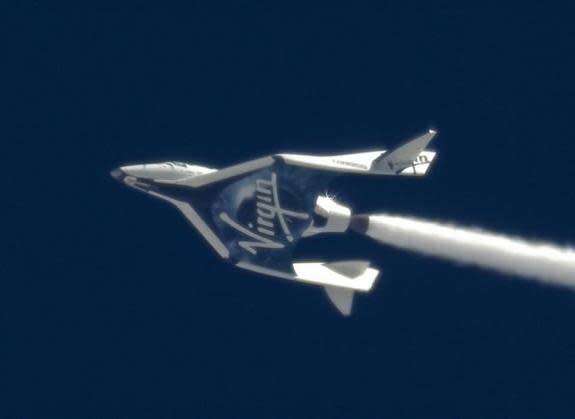 Science and Weather
Science and WeatherVirgin Galactic’s SpaceShipTwo makes first powered test flight

SpaceShipTwo, the suborbital spaceplane designed by Sir Richard Branson's private spaceflight company Virgin Galactic, ignited its main rocket engine for the first time in a test flight today, adding another success for Branson's company as they move towards offering suborbital spaceflights to the public.
The Virgin Galactic Twitter feed (@virgingalactic) excitedly reported on the milestone this morning:
For the 1st time ever, SS2 has lit her rocket engine in flight! A major milestone in human spaceflight. Photos, video, and details to follow
— Virgin Galactic (@virgingalactic) April 29, 2013
[ Related: Virgin Galactic's spaceship makes 1st powered flight test ]
"This is a momentous day and the single most important flight test to date for our Virgin Galactic program," Branson wrote afterwards in his blog. "What a feeling to be on the ground with all the team in Mojave to witness Virgin Galactic go faster than the speed of sound."
According to Branson, although both the rocket and the spacecraft have been tested extensively, they've done so separately. This marks the first time the two have been tested together, and this success will hopefully lead them to their first flight into space later this year.
"Like our hundreds of customers from around the world," he wrote "my children and I cannot wait to get on board this fantastic vehicle for our own trip to space and am delighted that today’s milestone brings that day much closer."
Unlike other spacecraft, which launch into space atop rockets, SpaceShipTwo is designed to take off from the ground slung under the central wing of the specially-designed WhiteKnightTwo aircraft. When the two craft reach the right altitude, WhiteKnightTwo releases SpaceShipTwo, which then ignites its rocket engine to boost it into orbit. Once it reaches its destination, SpaceShipTwo can then land like any conventional aircraft. The flights planned with SpaceShipTwo are considered 'suborbital', because it will not make a complete orbit around the planet, but instead will simply fly up from its departure starport, reach orbital heights, and then descend to its destination spaceport.
[ More Geekquinox: How big is space? These two sites will give you a sense ]
Virgin Galactic plans on offering commercial flights aboard SpaceShipTwo sometime in 2014. The $200,000 price-tag per ticket will be far too expensive for the majority of people to take advantage of this service to start, but as their fleet of spaceplanes grows and more competition joins the market, those price tickets should drop significantly. The benefit of this kind of flight isn't just novelty, either. Anyone who's taken long intercontinental flights might decide that if they're already paying around $2,000 for a 20-hour flight, it might be worth an extra cost to cut it down to just 90 minutes.
(Image courtesy: Reuters)
Geek out with the latest in science and weather.
Follow @ygeekquinox on Twitter!


